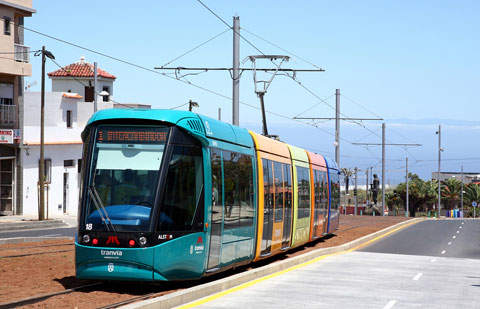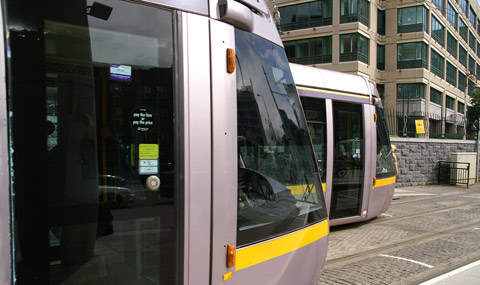Tenerife, the largest of Spain’s Canary Islands, is well known as a popular holiday destination. Visitors in recent years will have been aware of a major construction project on the streets of the island capital of Santa Cruz de Tenerife. Rail development authority Metropolitano de Tenerife was building the initial line of a new light rail system, Tranvia de Tenerife, the first in the Canaries archipelago.
An old-style streetcar operation between Santa Cruz and La Laguna had closed in 1951, and the only public transport in the region became buses, increasingly held up by congestion. As with many European cities, a growing population coupled with an ever-increasing number of private cars pointed to a need for a metro operation. Without a new mode of public transport, the Tenerife government expected gridlock on the city’s roads by 2012.
THE PROJECT
The corridor chosen for Line 1 is intended to provide around half of the Santa Cruz and La Laguna population of 350,000 with access to the system, with a maximum five minute walk. Some 44,000 daily journeys are expected to be made in the first year, eliminating over 9,500 car journeys.
Construction began in 2004 with the aim of revenue service by early 2007. The €306m cost,which included the tram fleet, is borne through a public-private partnership.
Metropolitano de Tenerife is a private company, but the main shareholder is the island’s government with a €58m holding.
Additional funding partners are the Canary Islands provincial government (€58.7m), Santa Cruz and La Laguna (€6.1m), European Investment Bank (€82m) and the European Regional Development Fund (€12.9m).
In addition, French public transport provider Transdev is investing €7m, Caja Canaries Bank €3m and the Spanish government €10m.
The route of Line 1 was chosen in 2000 through a feasibility study, is 12.3km (7.6 miles) long with 22 stops and opened in June 2007, carrying 400,000 in the first week of operation.
INFRASTRUCTURE
The route of Line 1 is steeply graded (600m in 12km) and included extensive improvements to the streets of Santa Cruz and La Laguna, plus relocation of utility pipes and cables beneath the ground. There are around 500–600m intervals between each stop, the whole route being double track.
Running rails were made by Corus Steel in a joint venture with Dragados, Comsa, FCC, Tecsa and Necso. These are grooved rails of type 35GP13 and approximately 3,000t of material was delivered to the site in 2005.
A 22,000m² maintenance depot has been designed for future growth and can accommodate 35 trams on nine tracks under cover, with 13 in the adjacent yard.
The project also aims to be entirely self sufficient. In accordance with Metropolitano de Tenerif policy the entire system, Train & LRT, aims to be 100% self efficient in terms of energy supply in 2020.
ROLLING STOCK
The popular Alstom Citadis tram was chosen, a type increasingly common throughout Europe. To cope with the demanding nature of the terrain with up to 8.5% gradients, the 720kW vehicles are equipped with all axles driven. To conserve energy, regenerative brakes are fitted, which are expected to save 20% over conventional braking systems.
The initial fleet is 20 type 302 trams constructed at Alstom’s Santa Perpetua de Mogoda, Barcelona plant, at a cost of €50m. The five-module, air-conditioned variant is 32.15m long, 2.40m wide, with space for 200 passengers, with 60 seated. To provide peak service, 17 trams are required. Subject to loadings, the trams may be extended in a similar manner to those of Dublin Red Line.
SIGNALLING AND COMMUNICATIONS
The contract to install signalling and communications systems was awarded to Efacec and Ikusi. This included the provision of signalling, CCTV, passenger information displays and fare collection equipment.
Line 1 end-to-end time is 37 minutes. Service frequency peaks at 5 minutes, extending in stages up to 20 minutes for daytime, with a 30-minute service through the night on Fridays and Saturdays. The local authority has introduced the Bono Via bi-mode ticket for journeys involving the extensive bus network Transportes Interurbanos de Tenerife, S.A.
THE FUTURE
Future plans for Line 1 include an extension from La Laguna (present terminus, La Trinidad) to nearby Tenerife Norte (Los Rodeos) airport which is expanding after the downturn that followed the 1978 opening of the island’s principal airport, Tenerife Sur (Reina Sofia).
Tenders in respect of the construction of a 2.3 km Line 2, La Cuesta to Tincer (from the north to south west of Santa Cruz), were issued in November 2007. For the extra demand on the line which is projected to open in 2009, six more trams will be ordered.
Metropolitano de Tenerife is also behind the project to create a railway joining Santa Cruz and Las Américas, major settlements in the north and south of the eastern side of the island. The aim of this ambitious plan is being able to cover the approximate 85km in around 45 minutes.










